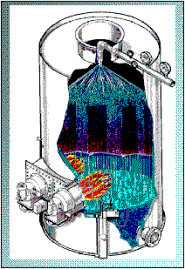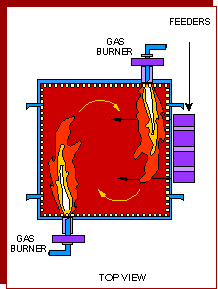|
Natural gas has a multitude of industrial uses, including
providing the base ingredients for such varied products
as plastic, fertilizer, anti-freeze, and fabrics. In
fact, industry is the largest consumer of natural gas,
accounting for 43 percent of natural gas use across
all sectors. Natural gas is the second most used energy
source in industry, trailing only electricity. Lighting
is the main use of energy in the industrial sector,
which accounts for the tremendous electricity requirements
of this sector. The graph below shows current as well
as projected energy consumption by fuel in the industrial
sector.
 |
| Industrial Primary Energy Consumption
by Fuel 1970 - 2020 |
| Source: EIA Annual
Energy Outlook 2002 With Projections to 2020 |
Although industry accounts for a great deal of natural
gas consumption in the United States, this industrial
consumption is concentrated in a relatively small number
of industries. Natural gas is consumed primarily in
the pulp and paper, metals, chemicals, petroleum refining,
stone, clay and glass, plastic, and food processing
industries. These businesses account for over 84 percent
of all industrial natural gas use.
Industrial Applications
Industrial applications for natural gas are many. Industrial
applications include those same uses found in residential
and commercial settings - heating, cooling, and cooking.
Click here
for a review of residential uses, and here
for a review of commercial uses. Natural gas is also
used for waste treatment and incineration, metals preheating
(particularly for iron and steel), drying and dehumidification,
glass melting, food processing, and fueling industrial
boilers. Natural gas may also be used as a feedstock
for the manufacturing of a number of chemicals and products.
Gases such as butane, ethane, and propane may be extracted
from natural gas to be used as a feedstock for such
products as fertilizers and pharmaceutical products.
Natural gas as a feedstock is commonly found as a building
block for methanol, which in turn has many industrial
applications. Natural gas is converted to what is known
as synthesis gas, which is a mixture of hydrogen and
carbon oxides formed through a process known as steam
reforming. In this process, natural gas is exposed to
a catalyst that causes oxidization of the natural gas
when brought into contact with steam. This synthesis
gas, once formed, may be used to produce methanol (or
Methyl Alcohol), which in turn is used to produce such
substances as formaldehyde, acetic acid, and MTBE (methyl
tertiary butyl ether) that is used as an additive for
cleaner burning gasoline. Methanol may also be used
as a fuel source in fuel cells. For more information
on the production of and uses for methanol, click here.
In addition to these uses, there are a number of innovative
and industry specific uses of natural gas. Natural gas
desiccant systems, which are used for dehumidification,
are increasingly popular in the plastics, pharmaceutical,
candy, and even recycling industries. In each of these
industries, moisture filled air can lead to damage of
the end product during its manufacture. For example,
in the plastics industry, moisture can cause cracks
and blemishes during the manufacture of certain types
of plastics. Adding a natural gas desiccant system to
the manufacturing or drying environment allows industrial
users to regulate more closely the amount of moisture
in the air, leading to a more consistent and high-quality
product. For more information on gas desiccant systems,
click here.
Natural gas absorption systems are also being used
extensively in industry to heat and cool water in an
efficient, economical, and environmentally sound way.
These industrial absorption systems are very similar
to those used in commercial settings. To learn more
about the technical aspects of absorption systems, particularly
absorption cooling systems, click here.
Infrared Heating Units
Infrared (IR) heating units provide an innovative and
economic method of using natural gas to generate heat
in an industrial setting. They are very useful in the
metals industry, as they provide innovative ways to
increase the efficiency of powder-coating manufacturing
processes. Infrared heaters use natural gas to more
efficiently and quickly heat materials used in this
process. Natural gas is combined with a panel of ceramic
fibers containing a platinum catalyst, causing a reaction
with oxygen to dramatically increase temperature, without
even producing a flame. Using natural gas in this manner
has allowed industry members to increase the speed of
their manufacturing process, as well as providing a
more economic alternative to electric heaters.
 |
| The Kemco Thermefficient-100
Direct Contact Water Heater |
| Source: Kemco Systems,
www.kemcosystems.com |
Direct Contact Water Heaters
Direct contact water heating is an application that
works by having the energy from the combustion of natural
gas transferred directly from the flame into the water.
These systems are incredibly efficient at heating water.
Normal industrial water heaters operate in the 60 -
70 percent energy efficiency range. However, direct
contact water heaters can achieve efficiencies up to
99.7 percent! Obviously, this leads to tremendous cost
savings in industries where hot water is essential.
To learn more about direct contact water heaters, click
here.
Industrial Combined Heat and Power
Industrial consumers reap great benefits from operating
natural gas Combined Heat and Power (CHP) and Combined
Cooling, Heat, and Power (CCHP) systems, similar to
those used commercial settings. For instance, natural
gas may be used to generate electricity needed in a
particular industrial setting. The excess heat and steam
produced from this process can be harnessed to fulfill
other industrial applications, including space heating,
water heating, and powering industrial boilers. Since
industry is such a heavy user of energy, and particularly
electricity, providing increased efficiency can save
a great deal of money. The industrial sector is also
subject to regulations regarding harmful emissions,
and the burning attributes of natural gas help industry
to reduce its emissions. To learn more about CHP/CCHP
systems, click here.
To learn more about the environmental advantages of
using natural gas in industrial processes, click here.
 |
| Schematic of a Natural Gas Co-fired
Boiler |
| Source: Acurex Energy,
www.cofire.com |
Industrial Co-firing
Natural gas co-firing technologies are also helping
to increase industrial energy efficiency, and reduce
harmful atmospheric emissions. Co-firing is the process
in which natural gas is used as a supplemental fuel
in the combustion of other fuels, such as coal, wood,
and biomass energy. For example, a traditional industrial
wood boiler would simply burn wood to generate energy.
However, in this type of boiler, a significant amount
of energy is lost, and harmful emissions are very high.
Adding natural gas to the combustion mix can have a
two-fold effect. Natural gas emits fewer harmful substances
into the air than a fuel such as wood. Since the energy
needed to power the natural gas boiler remains constant,
adding natural gas to the combustion mix can reduce
harmful emissions.
In addition, the operational performance of the boiler,
including its energy efficiency, can be improved by
supplementing with natural gas. For instance, in wood
fueled boilers, adding natural gas can compensate for
the use of low grade, wet wood, allowing it to combust
more quickly and completely. This type of co-firing
can also be used in the generation of electricity, whether
on-site or in a centralized power plant. To learn more
about natural gas and electricity generation, click
here. For
more information on natural gas co-firing technologies,
click here.
Natural gas has innumerable uses in industry, and new
applications are being developed every day. Natural
gas, being a clean, efficient source of energy and a
chemical building block, is an important part of successful
and environmentally sound industry in the United States.
To learn more about the environmental and technological
aspects of natural gas, click here.
Now that industrial uses of natural gas have been discussed,
click here
to learn about natural gas use in the transportation
sector!
|

